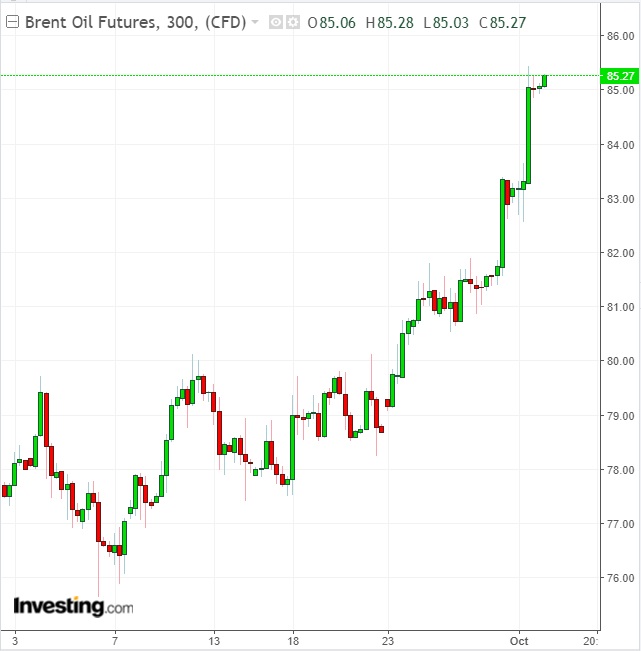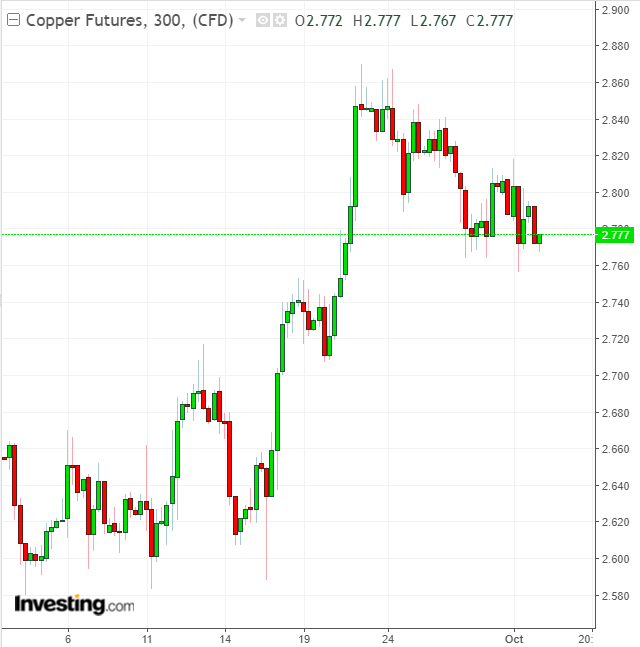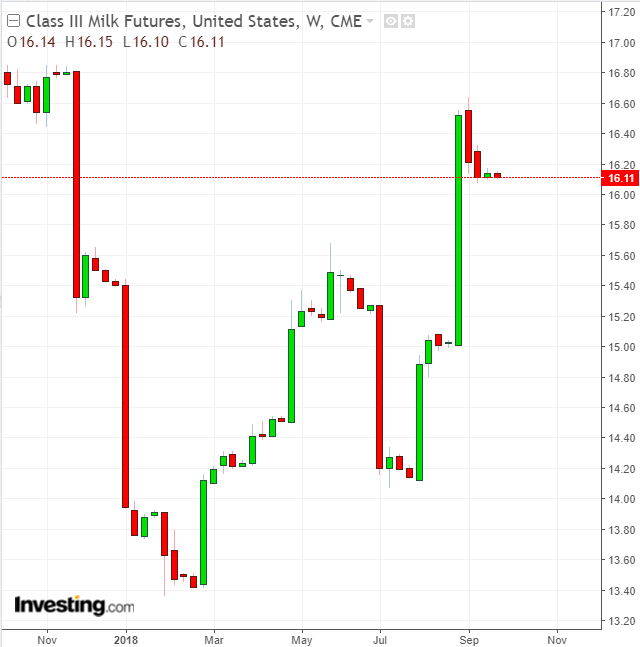For commodity traders, Donald Trump’s triumph in reworking NAFTA but refusing to do a trade deal with China promptly or start nuclear talks with Iran means there’s profit to be made in driving copper to below $2.50 a lb and oil to $100 a barrel and above.
US equity markets roared on the first day of the fourth quarter, with the Dow adding nearly 200 points, in reaction to the US-Mexico-Canada Agreement (USMCA) that replaces the 1994 North American Free Trade Agreement (NAFTA). White House trade advisor Peter Navarro proclaimed a “bullish day for America” and said the US won't be the world's "piggy bank" anymore.
But the reaction in commodities to the USMCA was measured, with oil being the outlier, more because of Iran than Canada or Mexico.

Brent crude oil jumped 3% to new four-year highs above $85 a barrel on continued fears about new US sanctions due on Iranian oil exports beginning November 4. A majority of Wall Street analysts believe Brent will hit $100 before the end of 2018 or by early next year without a conclusion to the crisis.
And while US copper moved down just 0.6% on the day, it was another commodity that deserved attention because of China’s insatiable demand for the infrastructure material.

Adam Sarhan, CEO at 50 Park Investments in New York, said Trump’s foot-dragging on a China trade deal “makes me inclined to ask my clients to sell copper down to $2.50 or below because that’s where it could go between now and a trade deal.” Copper settled at $2.788 per lb on Monday.
Some economists and foreign policy experts said the agreements achieved by the Trump administration with Mexico and Canada may bring incremental gains for America at best, as the deals could ultimately raise the cost of cars and other goods being rerouted to the US for manufacturing on the promise of bringing factory jobs back home. “Overall, the Trump administration creates a crisis, and then agrees to resolve it,” said Krzysztof Pelc, a global trade expert and political science professor at McGill University in Montreal.
Pelc says the good news about the USMCA “is that there’s an agreement at all, and that the looming uncertainty has been lifted as a result.” He adds:
“That’s what markets are reacting to, since the likelihood of no deal, and the resulting legal limbo, had already been priced in.”
Not Much To Milk From Dairy Deal?
Under the USMCA, Canada will provide US dairy farmers access to about 3.5 percent of an approximately $16 billion annual domestic dairy market, Reuters quoted trade sources as saying. Ottawa also agreed to eliminate classes and categories of milk that had effectively pushed US farmers out of the Canadian dairy market.
But Max Boot, a historian and foreign-policy analyst commenting through an opinion piece in the Washington Post, reminded dairy industry watchers that Washington still ran a $474 million dairy surplus with Ottawa last year, and US farmers sold five times more dairy goods to Canada than US consumers bought from Canada. “In any case, milk products represent just 0.06 percent of US-Canada trade, 99 percent of which was already tariff-free,” Boot wrote.
The US dairy futures market barely cheered the USMCA deal on Monday, with the most-actively traded US Class III Milk contract rising just 0.6% to settle at 15.90 cents a lb, Chicago Mercantile Exchange data showed.

On the contrary, US milk prices hit 10-month highs of 16.55 cents on September 2 when there was speculation of a deal favoring domestic farmers.
And while the other salient effort of the USMCA was to divert autos sold in North America from low-priced Mexican manufacturing, Boot said automakers could ultimately opt to pay a 2.5 percent duty to keep their factories in Mexico. They could also replace more workers with robots and redirect assembling outside of North America altogether. “Whatever happens, it is difficult to see how American consumers or even autoworkers will benefit,” he added.
China, Iran Standoffs More Complicated
If the USMCA is any guide, Trump’s challenge would be to wring out of China and Iran more meaningful concessions than gained from Mexico and Canada. “Certainly, there’s the expectation that with one down, there’s two more to go,” Dan Hueber, a St. Charles, Illinois-based grains markets specialist, said, referring to the theory that the North American agreement was the first of what would be a 3-way trade jigsaw win for the president.
Trump said on Monday that "China wants to talk very badly," but that he was putting it off. Washington slapped an additional 10% tariff on $200 billion on Chinese goods last month and Beijing retaliated with duties of $60 billion on American exports.
Soybeans rallied in Chicago trade to six-week highs of $8.64 per bushel on Monday, indicating recovery in a market once totally swayed by Chinese demand. To some traders, it was a sign that neither side might be in a rush to achieve a deal. “It could simply make it a lot harder,” Hueber said.
With Iran, the Trump administration is seeking restraints on Iran’s regional interference, aside from tighter scrutiny on its ballistic missile program and nuclear activities. Tehran has refused to negotiate on such terms, while continuing to adhere to an Obama-era nuclear deal to win support from European Union partners.
“The Iranian workaround to the Trump sanctions may actually be working as the Europeans seem determined to save the deal forged by Obama, which has effectively halted Iran’s nuclear advance,” Sarhan, the fund manager, said. He added: “So, oil may get nearer to $100 and Iran may benefit from exporting some of it too.”
